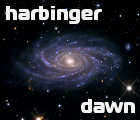|
The Universe's Edge
|
|
| neutronium76 | Date: Friday, 15.06.2012, 07:22 | Message # 16 |
 World Builder
Group: Users
 Greece
Greece
Messages: 718
Status: Offline
| Why are we spaculating about the possible existance of other sentient civilizations in other parallel universes? Isn't our universe "big" enough to accomodate another civilization together with ours? Or is our "ego" bigger? 
PC1:Core i7 970@3.34GHz, 6 cores/12 threads, 12GB DDR3 RAM@1.34GHz, 2x(SLI) GTX-580 GPUs 3GB VRAM(GDDR5)@1GHz, OS:Win7x64SP1
PC2:Core2Quad X9770@3.2GHz, 2 cores/4 threads 4GB DDR2 RAM@1GHz, GTX-285 GPU 1GB VRAM(DDR3)@1.24GHz, OS:WinVistax64SP2
|
| |
| |
| DoctorOfSpace | Date: Friday, 15.06.2012, 09:51 | Message # 17 |
 Galaxy Architect
Group: Global Moderators
 Pirate
Pirate
Messages: 3600
Status: Offline
| Quote (Talisman) How does that mean there are infinite amounts of other universes out there? If there are infinite amounts of universes then wouldn't that mean that there are so many that at least some of them would have a civilization that somehow broke out of their universe to visit another one, or some of them would visit our Earth? Infinity is an extremely crazy thing to comprehend and it allows paradox' like.
Not saying there are an infinite amount of universes simply saying there is a potential. And if the multiverse is real, that means that means that any number of possible universes can just happen. If the available time is infinite in the multiverse then there would be no beginning or end, anything that is possible and can happen will happen. That means that on such large scales and billions and billions of alternative universes there is another Earth and on it another you.
Quote (Talisman) If there are infinite other universes then there are an infinite amount of times where that universe blew up and destroyed ours.
But our universe is still here so far as we can tell so I guess that means it would just be a duplicate reality that was destroyed. 
Quote (Talisman) I think it's far more likely that we're actually in a simulation for another civilization that created Space Engine 8.93, which could then be in a simulation, and so on and so on, as according to probability we're very unlikely to be in the "Original" universe. I don't really believe this though, until we observe evidence of it, but it is possible.
That is possible but even then such civilizations would have other programs running simulations on different realities which would be its own kind of multiverse. And if the simulation of our reality is a 1:1 to their universe and the physics support a multiverse then a multiverse is still real. Doesn't matter if the universe is simulated.
Intel Core i7-5820K 4.2GHz 6-Core Processor
G.Skill Ripjaws V Series 32GB (4 x 8GB) DDR4-2400 Memory
EVGA GTX 980 Ti SC 6GB
Edited by DoctorOfSpace - Friday, 15.06.2012, 09:53 |
| |
| |
| Hasforjs97 | Date: Tuesday, 10.07.2012, 00:13 | Message # 18 |
 Space Pilot
Group: Translators
 Spain
Spain
Messages: 107
Status: Offline
| My opinion is the following:
When you travel in the same direction for Gpc and Gpc, you start deviating to one side, even tough you are travelling the same direction. Then, at a given time, you suddenly turn 180 degrees (you are still traveling in a straight line, but space deforms at the edge of the universe) so when you reach the edge, in less than 1 second, you make a half turn and go to the exactly oposide side of the sphere, so after maybe 1 Tpc you would be in the same point of space (not relative to galaxies, because they would have moved, but yes relative to the universe) where you were at the start.
Then I also think there are more universes, at different levels. I mean: inside this universe maybe there are very advanced civilizations that can create another universes (something like Talisman said, but it's not exactly a simulation, it's more something like microscopic universes (maybe atom-sized or even smaller), microscopic recreations of all the universe's life, or maybe yes it's a simulation, or maybe there are both things). So inside of this universe there are maybe one billion of smaller or simulated universes, and at the same time, this universe is a simulation or physic recreation of another civilization of another bigger universe. So there are infinite universes, yes, that's extremely possible.
Then the thing is: What if the main universe (the one at the highest level, that isn't inside any other) if there's actually an end in this chain, was destroyed? What if it just finishes, like all the universes finish. Well, a probability could be, that almost all the infinite universes of the "inception-like-leveled multiverse" depend on the first one. Maybe there are some simulated universes that are accelerated to finish all the proces in only 1 million years, and then expand and compress many times, but If the highest universe even finishes, all the others finish. And then there will be only one universe until some civilization on it can restart the chain by simulating or small-scale recreating another universe whose inhabitants can do the same, and creating lower and even lower levels until... boom, the main universe compresses again and the cycle starts again and again and again...
PD: After all of this, I have to say, there are a thing that annoys me so much: We, humans, are a very silly civilization, and maybe, in 200 years we will have destroyed Earth, and in 1000 years after sailing through the Galaxy, we will perish without even started to understand how the universe works...
My desktop:
Pentium G3260 @ 3.30GHz
8.0 GB DDR3
AMD Radeon HD 5570 1GB
Edited by Hasforjs97 - Tuesday, 10.07.2012, 00:16 |
| |
| |
| dontpanic | Date: Wednesday, 11.07.2012, 00:42 | Message # 19 |
 Space Pilot
Group: Users
 United States
United States
Messages: 113
Status: Offline
| Personally, I think the universe is infinite, there is no edge and you can't travel out. I think the emptiness just goes on forever even past the point where there are no stars anymore and no light (but something else...).
You don't have to look to the stars to see that infinity exists. Look at your table, for example. If you look at it with a microscope, you will see all of the atoms and molecules from which the table is made, and if you hadn't known it was a table you would have no way to know it actually IS a table. Now, say you could look at it at X100000000000000000000 magnification. What would you see? Would your view "bump into" or "hit" the surface of the atoms so you couldn't look any closer? No. You would see smaller particles from which the atoms consist. And you would be able to look even closer to see from what these particles are made.
My point is, if technology would allow it, you could "zoom-in" to infinity. And you would keep discovering new particles the further you "zoom-in". That shows that infinity is not just out beyond the observable universe, it is all around us. We are part of it. But we are "trapped" in this range, and we know nothing of what happens outside it, we can't look too far out to space and comprehend what is happening there, nor can we look too close in and see beyond a certain point.
Technology widens that range in both ways, we can look farther out to space and look closer down on objects. It is that range exactly that the first animation (http://htwins.net/scale2/) shows you. With time (and technology) that range will become wider but we will never be able to fully grasp it.
You can see this theory in many places, for example math. You can count up to infinity, but you can also count down in to negative numbers (also to infinity).
Physics also shows us infinity. An object with mass requires infinite energy to move with the speed of light, meaning no matter how much energy you have you will never quite have enough to move with the speed of light. That inability to reach infinity IS infinity. Just like you can't "zoom-in" right to the surface of an object or count to the last digit, and evidently reach the end of the universe.
-OR-
We just live in a virtual procedurally generated universe, not unlike Space Engine, made by a hyper advanced alien race, and all I said is a load of BS. But I doubt that. Still, who knows...
|
| |
| |
| Cael | Date: Wednesday, 11.07.2012, 09:35 | Message # 20 |
 Space Tourist
Group: Users
 Denmark
Denmark
Messages: 32
Status: Offline
| You summed up my exact thoughts, dontpanic!
I'm struggling grasping a finite universe, both looking in and out. But of course, in a quantum physics things behave weirdly, but that's not to say we can't look deeper. But I doubt we'll find a limit looking in.
Even if we did in fact reach a wall, being unable to "break" that wall would just prove that it has infinite strength and inwards depth. So there again - infinity.
Edited by Cael - Wednesday, 11.07.2012, 09:40 |
| |
| |
| dontpanic | Date: Wednesday, 11.07.2012, 10:07 | Message # 21 |
 Space Pilot
Group: Users
 United States
United States
Messages: 113
Status: Offline
| Good to have people who actually understand what you are trying to say 
|
| |
| |
| Cael | Date: Wednesday, 11.07.2012, 10:25 | Message # 22 |
 Space Tourist
Group: Users
 Denmark
Denmark
Messages: 32
Status: Offline
| It's funny though, a lot of people struggle with grasping infinity. I struggle more so with something finite (in physics terms of course. I know the alphabet is finite and can grasp that etc.)
|
| |
| |
| Neon | Date: Tuesday, 21.08.2012, 04:27 | Message # 23 |
|
Explorer
Group: SE team
 Australia
Australia
Messages: 208
Status: Offline
| There is really only one thing you can say for certain about the 'edge' of the Universe. There is an awful lot of
light there. We call it the Cosmic Background radiation. The left over remnant of the light from the BB.
HarbingerDawn is correct in current evidence from WMAP suggests the Universe is flat and infinite. It could
also be, that space is infinite but the current content of the universe is yet to expand into it. Who knows,
I tend not to form opinions without clear evidence.
However as I said, only thing for certain is there's alot of light there.
|
| |
| |
| HarbingerDawn | Date: Tuesday, 21.08.2012, 06:38 | Message # 24 |
 Cosmic Curator
Group: Administrators
 United States
United States
Messages: 8717
Status: Offline
| Quote (Neon) There is an awful lot of light there. We call it the Cosmic Background radiation. The left over remnant of the light from the BB.
The cosmic microwave background is not light from the expanding edge of the universe, it is light from back in time, early in the history of the universe. Any region near an "edge" of the universe would probably be similar to the regions that we see, with the exception of any boundary that might be there.
It's easy to think that any edge would be more energetic than the center, but that conclusion comes from thinking of the big bang as an explosion, and the edge as a shock front. That's not the case. The universe was approximately homogenous at the beginning, then it expanded and cooled. All regions of the universe should be roughly the same.
All forum users, please read this!
My SE mods and addons
Phenom II X6 1090T 3.2 GHz, 16 GB DDR3 RAM, GTX 970 3584 MB VRAM
|
| |
| |
| apenpaap | Date: Saturday, 25.08.2012, 19:34 | Message # 25 |
 World Builder
Group: Users
 Antarctica
Antarctica
Messages: 1063
Status: Offline
| The Cosmic Background radiation is basically the light of the Big Bang*, which has travelled 13.7 billion years and has redshifted all the way to microwaves in that time, not the actual edge of the universe. By now, any of the places it's from are just normal parts of the universe like our own.
* Not quite true; I think it was actually emitted a while later when the universe became transparant to light.
I occasionally stream at http://www.twitch.tv/magistermystax. Sometimes SE, sometimes other games.
|
| |
| |
| HarbingerDawn | Date: Saturday, 25.08.2012, 19:45 | Message # 26 |
 Cosmic Curator
Group: Administrators
 United States
United States
Messages: 8717
Status: Offline
| Quote (apenpaap) Not quite true; I think it was actually emitted a while later when the universe became transparant to light.
Yes. That epoch of the universe's history took place approximately 379 000 years after the Big Bang.
All forum users, please read this!
My SE mods and addons
Phenom II X6 1090T 3.2 GHz, 16 GB DDR3 RAM, GTX 970 3584 MB VRAM
|
| |
| |
| lexrazor | Date: Saturday, 25.08.2012, 20:43 | Message # 27 |
|
Astronaut
Group: Users
 Bulgaria
Bulgaria
Messages: 76
Status: Offline
| Or it could be the other way around and the Big Bang could still be happening there and we are in the past from the point of view of the moment it happened. Think of it as a wave which doesnt lose its power. The initial "blast" keeps on going and the consequences that follow after the wave are what we have in the known universe. Maybe that could explain why most of the galaxies we've seen from the HDF and HUDF look underdeveloped compared to the closer ones to the Milky Way. 
Or of course i could be making a huge fool of myself right now saying complete BS ^^"
|
| |
| |
| HarbingerDawn | Date: Sunday, 26.08.2012, 03:16 | Message # 28 |
 Cosmic Curator
Group: Administrators
 United States
United States
Messages: 8717
Status: Offline
| Quote (lexrazor) Think of it as a wave which doesnt lose its power. The initial "blast" keeps on going and the consequences that follow after the wave are what we have in the known universe.
But there is no wave. The Big Bang was not an explosion (one of the reasons I really dislike the name). It was simply the event that marked the origin of the universe from its primordial singularity (that particular detail may rendered inaccurate as our understanding of physics improves). Spacetime developed as the energy from the event expanded and cooled. Perhaps 4D spacetime existed immediately, or perhaps the dimensions appeared one at a time in sequence as the temperature decreased (there is evidence to support this). In any case, all of space was uniformly packed with energy, and as that space expanded the energy dispersed with it and so the overall temperature decreased. This was all homogenous, everywhere was the same as every place else. There was no center and no edge, no explosion and no blast wave.
Quote (lexrazor) Maybe that could explain why most of the galaxies we've seen from the HDF and HUDF look underdeveloped compared to the closer ones to the Milky Way.
The galaxies look underdeveloped because we see them as they looked many billions of years ago, when the universe was much younger. The speed of light is finite, and so light takes a certain amount of time to travel from one place to another. This means that when the light arrives at an observer at a later time, the observer sees the object as it was when the light originated. The farther away something is, the farther back in time you're seeing it, so when we look very deep into the universe we are primarily looking back in time more than out in space.
All forum users, please read this!
My SE mods and addons
Phenom II X6 1090T 3.2 GHz, 16 GB DDR3 RAM, GTX 970 3584 MB VRAM
|
| |
| |
| SlyReaper | Date: Saturday, 01.09.2012, 14:26 | Message # 29 |
 Observer
Group: Users
 United Kingdom
United Kingdom
Messages: 18
Status: Offline
| Quote (Talisman) And if it's "impossible" to leave a universe or enter another one or send any form of information from other universes then how can we detect other universes? If there's no way we can detect, see, record, visit any signs of unlimited universes then what is the point of thinking that's how it is?
For one thing, the physical laws of this universe seem to be fine tuned to allow the emergence of intelligent life. If this really is the only universe that will ever exist, then that's a hell of a coincidence. Postulating the existence of other universes with other physical laws potentially answers that problem. Simply, if there are enough of them, then the emergence of one with physical laws which permit life becomes inevitable.
There may never be any direct proof of the existence of other universes, but so long as you acknowledge it as speculation, then you can try the idea out, and see if reality makes any more sense by it. And we may be able to infer the existence of other universes eventually. The clue may lie in the weakness of gravity compared to the other known forces, or the space-time geometry of the early universe, replicated in a particle collider, or abnormalities in the cosmic background microwave radiation.
|
| |
| |
| HarbingerDawn | Date: Saturday, 01.09.2012, 14:44 | Message # 30 |
 Cosmic Curator
Group: Administrators
 United States
United States
Messages: 8717
Status: Offline
| Quote (SlyReaper) For one thing, the physical laws of this universe seem to be fine tuned to allow the emergence of intelligent life.
You could argue that they are fine tuned if you can demonstrate that life does in fact require all these physical constants to be very nearly exactly as they are, and if you can demonstrate that other universes do not and have not existed. As far as I know neither of those things has been demonstrated. I just dislike it when people use the term "fine tuned" because it implicitly invokes intelligent design.
Quote (SlyReaper) There may never be any direct proof of the existence of other universes, but so long as you acknowledge it as speculation, then you can try the idea out, and see if reality makes any more sense by it. And we may be able to infer the existence of other universes eventually. The clue may lie in the weakness of gravity compared to the other known forces, or the space-time geometry of the early universe, replicated in a particle collider, or abnormalities in the cosmic background microwave radiation.
I think that one day, if humanity and science continue to exist and progress, we will know the answers about how our universe got here and whether there are or were others.
All forum users, please read this!
My SE mods and addons
Phenom II X6 1090T 3.2 GHz, 16 GB DDR3 RAM, GTX 970 3584 MB VRAM
|
| |
| |